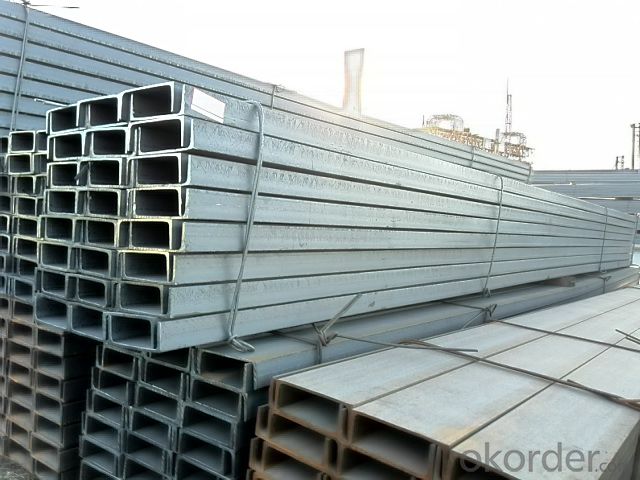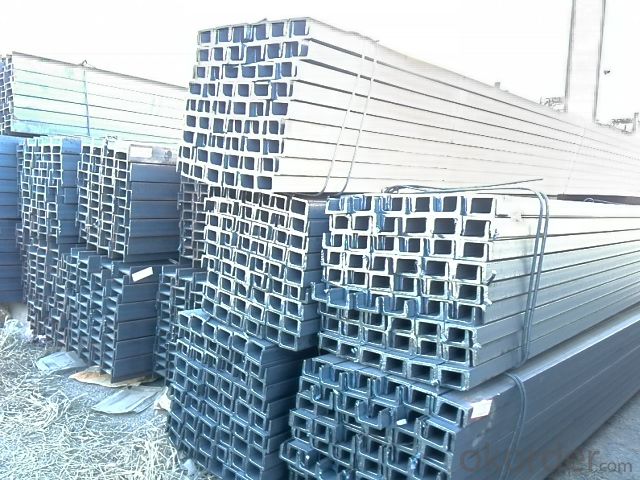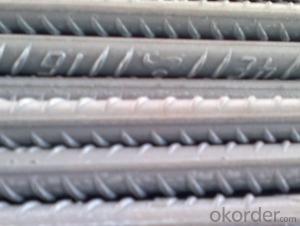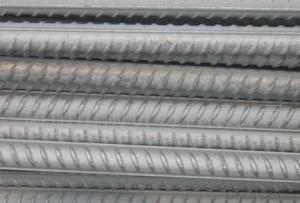U-channels In Japanese Standard with High Quality
- Loading Port:
- Tianjin
- Payment Terms:
- TT OR LC
- Min Order Qty:
- 25 m.t.
- Supply Capability:
- 10000 m.t./month
OKorder Service Pledge
OKorder Financial Service
You Might Also Like
Product Description:
| Minimum Order Quantity: | 25MT | Unit: | m.t. | Loading Port: | Xingang Port |
| Supply Ability: | 120000TON/Year | Payment Terms: | TT or LC |
Product Applications:
Japanese Standard U-channels are ideal for structural applications and are widely used in the construction of buildings and bridges, and the manufacturing, petrochemical, and transportation industries.
Product Advantages:
OKorder's Japanese Standard U-channels are durable, strong, and resist corrosion.
Main Product Features:
· Premium quality
· Prompt delivery & seaworthy packing (30 days after receiving deposit)
· Corrosion resistance
· Can be recycled and reused
· Mill test certification
· Professional Service
· Competitive pricing
Product Specifications:
Manufacture: Hot rolled
Grade: Q195 – 235
Certificates: ISO, SGS, BV, CIQ
Length: 6m – 12m, as per customer request
Packaging: Export packing, nude packing, bundled
1. We are definitely speciallizing in manufacturing and supplying channel steel as per japanese standard, which is characterised with high mechanical strength and competitive prices.
Original Place | Tangshan, China | Brand Name | UINDA |
Standard | JIS G3192 : 1990 | ||
Material Grade | SS490 | ||
Sizes | 50mm to 200mm | ||
Sales Volume/Year | 3000MT | ||
Destination Area | Middle East, Africa, Southeast Asia | ||
2. The sections in details are as followings in the table-1
JIS U CHANNEL | Standard | Sectional | Dimension |
| Mass: |
| (mm) | (mm) | (mm) | (mm) |
|
50x25 | 50 | 25 | 3.0 | 6.00 | 2.37 |
75X40 | 75 | 40 | 3.8 | 7.00 | 5.30 |
75X40 | 75 | 40 | 4.0 | 7.00 | 5.60 |
75X40 | 75 | 40 | 4.5 | 7.00 | 5.85 |
75X40 | 75 | 40 | 5.0 | 7.00 | 6.92 |
|
|
|
|
|
|
100X50 | 100 | 50 | 3.8 | 6.00 | 7.30 |
100X50 | 100 | 50 | 4.2 | 6.00 | 8.03 |
100X50 | 100 | 50 | 4.5 | 7.50 | 8.97 |
100X50 | 100 | 50 | 5.0 | 7.50 | 9.36 |
|
|
|
|
|
|
125X65 | 125 | 65 | 5.2 | 6.80 | 11.66 |
125X65 | 125 | 65 | 5.3 | 6.80 | 12.17 |
125X65 | 125 | 65 | 5.5 | 8.00 | 12.91 |
125X65 | 125 | 65 | 6.0 | 8.00 | 13.40 |
|
|
|
|
|
|
150x75 | 150 | 75 | 5.5 | 7.30 | 14.66 |
150x75 | 150 | 75 | 5.7 | 10.00 | 16.71 |
150x75 | 150 | 75 | 6.0 | 10.00 | 17.90 |
150x75 | 150 | 75 | 6.5 | 10.00 | 18.60 |
150x75 | 150 | 75 | 6.5 | 10.00 | 24.00 |
|
|
|
|
|
|
200X80 | 200 | 80 | 7.5 | 11.00 | 24.60 |
Table-1
3. The mechanical property of JIS U Channel Steel in the table-2:
Grade | Yield Strength,N/mm² | Extension Strength N/mm² | |||
Thickness of Steel,mm | |||||
≦16 | >16-≦40 | >40-≦100 | >100 | ||
SS490 | ≧285 | ≧275 | ≧255 | ≧245 | 490-610 |
Table-2
4. The chemical composition of JIS U Channel Steel as per SS490 in the table-3
Grade | Element(%) | |||
C | Mn | P | S | |
SS490 | - | - | ≦0.050 | ≦0.050 |
Table-3
FAQ:
Q1: Why buy Materials & Equipment from OKorder.com?
A1: All products offered byOKorder.com are carefully selected from China's most reliable manufacturing enterprises. Through its ISO certifications, OKorder.com adheres to the highest standards and a commitment to supply chain safety and customer satisfaction.
Q2: How do we guarantee the quality of our products?
A2: We have established an advanced quality management system which conducts strict quality tests at every step, from raw materials to the final product. At the same time, we provide extensive follow-up service assurances as required.
Q3: The products are invoicing on theoritical weight or on actual weight?
A3: We can do it in both manners, according to the customers' request.
Images:

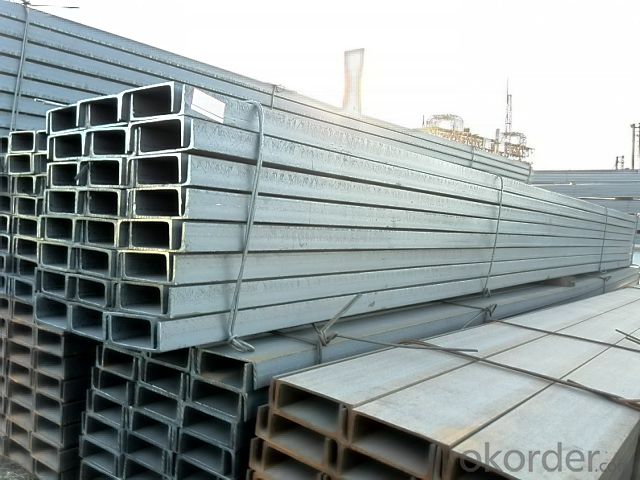

- Q: Can steel rebars be used in pre-tensioned concrete structures?
- No, steel rebars cannot be used in pre-tensioned concrete structures. Pre-tensioned concrete structures require the use of high-strength, prestressed steel strands that are tensioned before the concrete is cast, providing the necessary strength and structural integrity.
- Q: Can steel rebars be used in structures exposed to extreme weather conditions?
- Yes, steel rebars can be used in structures exposed to extreme weather conditions. Steel rebars have excellent strength and durability, making them suitable for withstanding harsh environmental conditions including extreme temperatures, high humidity, and heavy rainfall. Additionally, steel rebars are resistant to corrosion, which is crucial in structures exposed to extreme weather as it helps maintain their structural integrity over time.
- Q: How are steel rebars tested for quality control?
- Steel rebars are tested for quality control through various methods such as visual inspection, dimensional checks, and mechanical testing. Visual inspection ensures that the rebars are free from surface defects, cracks, or other abnormalities. Dimensional checks verify the length, diameter, and shape of the rebars to ensure they meet the required specifications. Mechanical testing, including tensile and bend tests, assesses the rebars' strength, ductility, and resistance to deformation. These quality control measures ensure that the steel rebars meet the necessary standards and are fit for their intended use in construction and reinforcement projects.
- Q: What is the effect of carbon content on the strength of steel rebars?
- The strength of steel rebars is significantly affected by their carbon content. Generally, a higher carbon content results in increased strength and hardness in the steel rebars. This occurs because carbon atoms create strong chemical bonds with iron atoms in the steel matrix, resulting in a more rigid and durable material. When carbon is added to the steel, it forms carbides, which are crystalline compounds that enhance the hardness and strength of the steel. The presence of these carbides improves the steel rebars' resistance to deformation, making them suitable for applications that require high strength, such as construction and infrastructure projects. Nevertheless, it is important to consider that there is a limit to how much carbon can be added to the steel rebars to enhance their strength. Excessive carbon content can make the steel brittle and prone to cracking when subjected to stress. This is because excessive carbon atoms can form large clusters of carbides, weakening the overall structure of the steel rebars. Therefore, it is crucial to carefully balance the carbon content in steel rebars to achieve the desired strength and toughness. Depending on the specific application and requirements, different levels of carbon can be utilized to optimize the strength and performance of the steel rebars. In conclusion, the carbon content directly affects the strength of steel rebars. Increasing the carbon content can enhance their strength and hardness, but excessive levels of carbon can result in brittleness. Hence, finding the appropriate balance of carbon content is essential to ensure the optimal strength and performance of steel rebars in various construction applications.
- Q: What is the role of steel rebars in bridge deck construction?
- The construction of bridge decks relies heavily on steel rebars, which play a vital role in reinforcing the concrete. Their main purpose is to enhance the tensile strength of the concrete since it is naturally strong in compression but weak in tension. Bridge decks are subject to various loads, including the weight of vehicles, live loads, temperature changes, and vibrations from the environment. Insufficient tensile strength in the bridge deck can result in bending, cracking, or even collapse under these loads. By incorporating steel rebars into the concrete structure of the bridge deck, the tensile strength is significantly improved. These rebars are strategically placed throughout the concrete to effectively distribute loads and resist tension, preventing cracks and ensuring the overall structural integrity of the bridge. Aside from reinforcing the concrete, steel rebars also serve to control cracks caused by shrinkage or thermal expansion. When the concrete shrinks or expands, cracks can form, compromising the durability and stability of the bridge. However, the inclusion of rebars helps to regulate and limit the size and extent of these cracks, ensuring the long-term performance of the bridge. Moreover, steel rebars also assist in transferring loads between different components of the bridge, such as the bridge deck and the supporting piers or abutments. They facilitate the creation of a continuous load path, guaranteeing efficient transmission and distribution of loads throughout the bridge structure. To summarize, the presence of steel rebars is crucial in bridge deck construction as they provide the necessary tensile strength to the concrete. They enhance the structural integrity of the bridge, control cracks, and enable efficient load transfer, ultimately ensuring the safety and longevity of the bridge.
- Q: How long do steel rebars last in a concrete structure?
- Steel rebars can last for several decades in a concrete structure, typically up to 50-100 years or even longer, depending on various factors such as the quality of steel used, environmental conditions, maintenance practices, and exposure to corrosive elements.
- Q: Are there any environmental benefits to using steel rebars?
- There are numerous environmental advantages to utilizing steel rebars in construction. Here are some of the main benefits: 1. Recyclability: Steel rebars possess a high degree of recyclability, enabling them to be reused or repurposed once their lifespan in a structure comes to an end. This diminishes the need for new steel production and the associated energy consumption and greenhouse gas emissions. In fact, steel is one of the most widely recycled materials worldwide, boasting a recycling rate of approximately 90%. 2. Durability: Steel rebars are renowned for their strength and durability, granting structures a longer lifespan. This lessens the necessity for frequent replacements or repairs, resulting in reduced waste generation and the conservation of resources. 3. Energy efficiency: Steel production has become increasingly energy-efficient over time, thanks to advancements in technology and processes. This signifies that the environmental impact of steel production has been decreasing, making it a more sustainable choice in comparison to other materials. 4. Reduced deforestation: Steel rebars provide an alternative to timber reinforcement, which is often acquired through deforestation practices. By opting for steel rebars instead, we can help alleviate the pressure on forests and safeguard their invaluable ecosystem services. 5. Waste reduction: Steel rebars can be prefabricated and cut to precise lengths, minimizing waste on construction sites. Additionally, the scrap generated during the fabrication process can be recycled, further reducing waste generation. In conclusion, the utilization of steel rebars in construction offers a variety of environmental benefits, including recyclability, durability, energy efficiency, reduced deforestation, and waste reduction. These advantages contribute to a more sustainable and eco-friendly construction industry.
- Q: What is the role of steel rebars in beam and column design?
- The role of steel rebars in beam and column design is to provide reinforcement and enhance the structural strength and stability of the concrete elements. Rebars are embedded within the concrete to resist tensile forces and prevent cracking or failure under heavy loads. By increasing the overall durability and load-bearing capacity, steel rebars ensure the structural integrity and longevity of beams and columns.
- Q: Why does the steel thread have longitudinal ribs?
- The main function of the longitudinal ribs is the force to improve the performance of the transverse ribs, the stress of support surface transverse rib in the longitudinal direction, reducing flange stress concentration, so as to improve the mechanical strength of the reinforced rib, deformation of bond between concrete and steel reinforced concrete, the collaborative work and better.The effect of the longitudinal ribs is indirect, which improves the mechanical properties of the transverse ribs and indirectly enhances the bond with the concrete.
- Q: How do steel rebars improve the strength of concrete?
- Steel rebars improve the strength of concrete by providing reinforcement and enhancing its structural integrity. The rebars act as a skeleton, distributing and transferring the load across the concrete structure. This prevents cracks and increases the overall tensile strength of the concrete, making it more resistant to bending, shearing, and other external forces.
Send your message to us
U-channels In Japanese Standard with High Quality
- Loading Port:
- Tianjin
- Payment Terms:
- TT OR LC
- Min Order Qty:
- 25 m.t.
- Supply Capability:
- 10000 m.t./month
OKorder Service Pledge
OKorder Financial Service
Similar products
Hot products
Hot Searches
Related keywords



